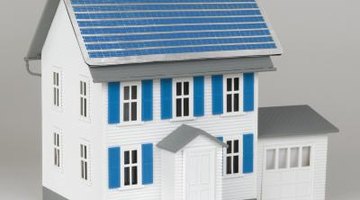Garage Leaking Water Through the Walls
Because garages are not finished to the same quality standards as the living areas of homes are, garages are more likely to suffer from occasional leaks. But leaking water anywhere in a home's structure is cause for concern because it increases the risk of structural damage and mold growth. If water’s leaking through a garage wall, the culprit could be one of a number of problems. Finding and fixing the leak is essential, and then you can focus on repairing any damage caused by the water.
Roof

Even though the leak appears on the wall of the garage, there’s a good chance the water’s coming from the roof and traveling along the rafters and then down the wall studs. If the roof is new, the problem might be the result of improper flashing around a vent or in a roof valley, where the framing changes directions. Correct flashing is a method of installing shingles in combination with metal flashing strips so that water runs off instead of under the shingles. Other roof problems that can trigger leaks include missing shingles or shingles that do not seal down properly.
Doors and Windows
If the leak is in close proximity to a door or a window, it may be another flashing issue, this time around the top of the door or window frame. Because the exterior frame of a door or window usually extends a little farther than the siding and because installation requires that the siding be cut, water leaks are likely to occur here. Flashing above doors and windows is usually made from thin sheet metal, painted to match the color of the house trim. If the flashing is bent, damaged or nonexistent, water can run down the siding and enter a crack above the window or door.
Sill Plate
Between the garage foundation and the wall framing is the sill plate. Sill plates are generally made from treated lumber and bolted tightly to the foundation. Unfortunately, sill plates are not watertight. If your garage foundation is low and rainwater or water from your guttering runs out along the sill plate, it could leak into the garage at the bottom of the wall. If you can’t find any sign of water higher on the wall, leaking at the sill plate is likely. Routing water away from the foundation by raising the grade of the yard or by installing long downspouts may help.
Other Issues
While less common, other issues can also trigger leaks in a garage wall. Blowing rain can enter under improperly installed siding. In cold climates where snow is common, an attic gable vent may allow blowing snow to enter the attic and form a little drift that melts and runs down the wall framing when the temperature rises. If the leak occurs soon after any type of siding, roof or vent installation, however, call your contractor because the problem is likely related to the recent work.
Writer Bio
Glenda Taylor is a contractor and a full-time writer specializing in construction writing. She also enjoys writing business and finance, food and drink and pet-related articles. Her education includes marketing and a bachelor's degree in journalism from the University of Kansas.
Photo Credits
- Jupiterimages/Comstock/Getty Images
More Articles



